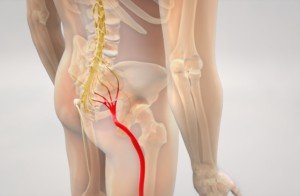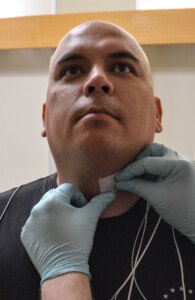Extruded or Herniated Disc: Long Term Effects
The long term effects of an extruded or herniated disc vary depending on the degree of bulging out of the disc contents, or the leaking of the inner disc fluid into the spinal canal. (more…)
Why Old People First Don’t Hear You, then Suddenly Understand

Ever notice that often, when speaking to an elderly person, they ask you to repeat it — but then suddenly they understood everything you said?
Is this hearing loss or a “senior brain” taking a little longer to catch up?
Can Sciatica Cause Twitching Muscles in the Butt or Leg?

You’ve been noticing some twitching going on in your butt and/or leg muscles, and are hoping it’s due to your sciatica rather than ALS.
Muscle fasciculations can be caused by ALS, and “fasciculation” refers to twitching.
This makes many people terrified that a new-onset twitching — whether it’s very focal or widespread — might be the beginnings of ALS.
Can Sciatica Cause Muscles to Twitch?
“Yes; a muscle twitch is an indication of the pressure of the nerve, which means the nerve is under compression,” says Alfred O. Bonati, MD, owner of The Bonati Institute, a world leader in advanced spine surgery, Hudson, FL.
“This pressure on the nerves can be corrected by opening the canals to decompress the site that is pressing the nerve,” continues Dr. Bonati.
In sciatica, the sciatic nerve, which branches out from the spinal cord, is compressed or “pinched” by a vertebral disc.

The sciatic nerve. Shutterstock/Nathan Devery
This compression classically causes shooting pain down the leg, sometimes starting at the buttocks level. It can be sudden and quite severe, even stabbing or piercing.
Numbness and tingling may also be associated with sciatica.
Typically, sciatica affects one side of the body. The pain has also been described as as burning.
When a patient is having these kinds of symptoms, a little muscle twitching in the same vicinity might not even be noticed.
“The other thing is if a patient has a twitch or nerve affected in different areas, that can be associated with a neurological disease,” says Dr. Bonati.
“So, the patient will need to be evaluated for a neurological illness.”
Muscle twitching is normally a benign condition and affects just about everyone sooner or later, and for some people it’s very frequent, including daily.
A person could by chance have both sciatica and benign muscle twitching located well-beyond the area that’s being affected by the sciatica.
An individual can have both sciatic symptoms and benign fasciculation syndrome: persistant muscle twitching that’s often accompanied by cramping of the muscles.
These are separate conditions, though; one does not cause the other.
The leading causes of twitching muscles are exercise, physical activity, fatigue, stress, anxiety and mineral imbalance.
The big red flag is if the twitching is accompanied by weakness in the associated muscle, visible atrophy in that muscle, or the presence of uncontrolled tremoring or shaking (the latter is not the same as fasciculations).
There is also something you need to be aware of: the phenomenon of perceived weakness.
You want to be sure that you do not get caught up in the entanglement of perceived weakness.
- Low back or buttocks pain
- Hip or pelvic pain
- Pain radiating down one leg
- Pain anywhere in a leg
- Pain anywhere in a foot
- Pain that’s sharp, shooting or stabbing
- Burning or electric shock pain
- Pain can be deep or superficial
- Pain worsened by sitting or standing
- Pain worsened by walking or bending
- Pain worsened by coughing or sneezing
- Pain relieved by lying down
- Numbness in the buttocks or leg
- Numbness anywhere in the foot
- Tingling or prickly sensations
- Leg or foot weakness, foot drop
- Muscle wasting (chronic cases)
- Increased pain or numbness on a toilet
 Dr. Bonati, is a board certified orthopedic surgeon and was the first to develop and patent methods and instruments for laser assisted spine surgery – The Bonati Spine Procedures – for cervical, thoracic and lumbar spine problems.
Dr. Bonati, is a board certified orthopedic surgeon and was the first to develop and patent methods and instruments for laser assisted spine surgery – The Bonati Spine Procedures – for cervical, thoracic and lumbar spine problems.
 Lorra Garrick has been covering medical, fitness and cybersecurity topics for many years, having written thousands of articles for print magazines and websites, including as a ghostwriter. She is also a former ACE-certified personal trainer.
Lorra Garrick has been covering medical, fitness and cybersecurity topics for many years, having written thousands of articles for print magazines and websites, including as a ghostwriter. She is also a former ACE-certified personal trainer.
Top image: Shutterstock/Shidlovski
When Sleep Apnea Occurs Only when Falling Asleep
Why is it that the only apnea episodes that awaken you are seemingly only those that occur just as you’re falling asleep?
Five Things Never to Say to Someone with Sleep Apnea

Being prepped for a sleep study.
Here are 5 things that you should never say to someone who has sleep apnea – which, by the way, you yourself might have!
After all, sleep apnea is one of the most underdiagnosed medical conditions.
There are countless cases of people who go years with untreated symptoms until finally the correct diagnosis is made. (more…)
Why You Can’t Fully Open Mouth After Wisdom Teeth Removal

For some people who will undergo wisdom teeth removal, they will find that opening their mouth fully following the procedure will be problematic, while others will not have this problem.
“The inability to open the mouth fully after wisdom tooth removal is usually due to the stretching of the muscles and ligaments of the face during the extraction,” explains Guy M. Hanson, DDS, MBA, MAGD, Academy of General Dentistry.
“Since the wisdom teeth are the teeth furthest back in the mouth, it is often necessary to open the mouth wider than normal in order to access them. Many individuals do not experience this issue.”
For the days following the removal of your wisdom teeth, you will be instructed not to eat solid foods.
In fact, you’ll be permitted only beverages like water and juice, and broth soups in the days immediately following the extraction.
So you don’t have to worry about not being able to fully open your mouth during the first week.
- The situation is temporary.
- Think of it as sore muscles from a workout.
They will need their rest and will recover.
Dr. Hanson retired in 2014 after practicing dentistry for 35 years at the former Idaho Dental Wellness Center.
 Lorra Garrick has been covering medical, fitness and cybersecurity topics for many years, having written thousands of articles for print magazines and websites, including as a ghostwriter. She’s also a former ACE-certified personal trainer.
Lorra Garrick has been covering medical, fitness and cybersecurity topics for many years, having written thousands of articles for print magazines and websites, including as a ghostwriter. She’s also a former ACE-certified personal trainer.
.
Top image: Shutterstock/marinafrost
How Normal Is Pain Two Weeks After Wisdom Teeth Removal?

“It is not uncommon for a wisdom tooth extraction site to be uncomfortable for several weeks,” explains Guy M. Hanson, DDS, MBA, MAGD, Academy of General Dentistry.
“The discomfort should diminish on a continual basis,” says Dr. Hanson.
“The discomfort is usually in proportion to the amount of tissue damage experienced during the extraction procedure.
“If bone is removed, the discomfort period is longer than if no bone is removed.
“If an incision is made and sutures placed, the discomfort will usually last longer than if no incision was made.”
You will receive instructions for postoperative care including for how long to avoid solid food, and how to manage the pain with medications.
Dr. Hanson retired in 2014 after practicing dentistry for 35 years at the former Idaho Dental Wellness Center.
 Lorra Garrick has been covering medical, fitness and cybersecurity topics for many years, having written thousands of articles for print magazines and websites, including as a ghostwriter. She’s also a former ACE-certified personal trainer.
Lorra Garrick has been covering medical, fitness and cybersecurity topics for many years, having written thousands of articles for print magazines and websites, including as a ghostwriter. She’s also a former ACE-certified personal trainer.
.
Top image: Shutterstock/GlebSStock
Flu-Like Symptoms After Wisdom Teeth Removal: Cause, Solution

Following the removal of wisdom teeth, the patient may end up with symptoms resembling the flu, confining them to bed. (more…)
The Worst Possible Outcome of Wisdom Teeth Removal ?

The worst possible thing that could happen to you as a result of wisdom teeth removal will shock the daylights out of you.
“The worst possible outcome of wisdom tooth removal is death,” says Guy M. Hanson, DDS, MBA, MAGD, Academy of General Dentistry. (more…)
What Causes Acne to Be Worse on One Side of the Face?

If you think your acne is worse on one side of your face, you’re probably right.
This can definitely happen, and it has more than one cause.
“Acne can appear to be worse on one side of the face when it is due to occlusion from a cell phone or resting your hand on that side of the face, as well as the dirt and grease that are harbored on those things,” says Estee Williams, MD, a board certified medical, cosmetic and surgical dermatologist and assistant clinical professor in dermatology at Mount Sinai Medical Center.



























































